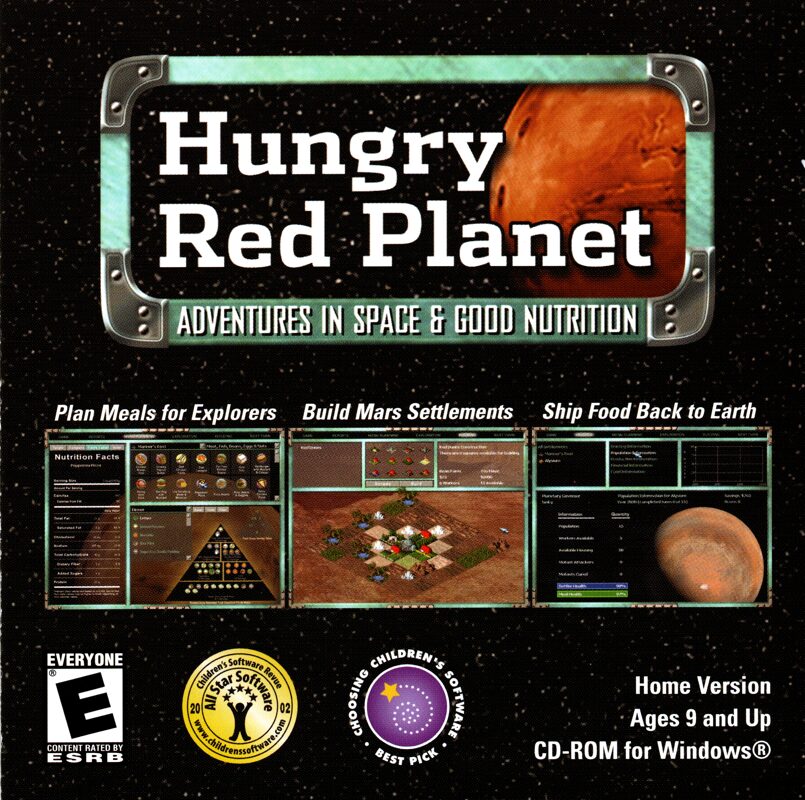Retro Replay Review
Gameplay
Hungry Red Planet blends educational content with turn-based strategy, creating a unique gameplay loop that encourages children to learn about balanced meals while exploring a hostile Martian environment. Players navigate an isometric map of Mars, allocating limited action points to move their crew, gather resources, and engage with mutant creatures that roam the red dunes. The strategic layer feels approachable yet substantial, letting young gamers experiment with positioning, resource management, and tactical decisions without overwhelming them with complex mechanics.
(HEY YOU!! We hope you enjoy! We try not to run ads. So basically, this is a very expensive hobby running this site. Please consider joining us for updates, forums, and more. Network w/ us to make some cash or friends while retro gaming, and you can win some free retro games for posting. Okay, carry on 👍)
The core nutritional mechanic centers on a drag-and-drop food pyramid interface, where players assemble meals for their settlers. This interface is intuitive: fruits, vegetables, proteins, and grains appear in distinct slots, and combining the right proportions results in bonuses like increased morale or temporary stat boosts. Kids quickly grasp the cause-and-effect link between healthy choices and in-game benefits, reinforcing real-world lessons on nutrition through positive feedback and colorful animations whenever a balanced meal is served.
Beyond the meal-building minigame, Hungry Red Planet challenges players to maintain a self-sustaining settlement. You must allocate resources to build greenhouses, water extractors, and defensive turrets, all while exploring nearby Martian caverns for rare minerals. The alternating focus between strategic base-building, meal preparation, and turn-based skirmishes keeps the pace brisk and varied, ensuring that younger audiences remain engaged across multiple gameplay modes.
Graphics
The art style of Hungry Red Planet strikes a charming balance between cartoonish whimsy and sci-fi flair. Settlements gleam under a dusty red sky, with each building rendered in crisp, colorful detail that stands out against the muted Martian landscape. Characters sport oversized helmets and expressive faces, making it easy for children to identify with their avatars and understand their emotional states—happiness, fatigue, or hunger—at a glance.
On the isometric map, terrain elevation and resource nodes are clearly indicated, allowing players to plan their movements strategically. Animations are smooth, from the gentle swaying of hydroponic plants in greenhouses to the dramatic stomp of a mutant crawler charging at your crew. Visual effects for special meals—like a glowing aura around well-nourished settlers—offer satisfying feedback that reinforces the educational objectives.
User interface elements remain clean and accessible, with large icons for food groups and equipment. The food pyramid menu is organized logically, avoiding clutter and making it easy for younger players to experiment with different combinations. Even during combat, the HUD remains unobtrusive, presenting health bars and action options without obscuring the vibrant backdrop of Mars.
Story
Hungry Red Planet casts you as the commander of the Helios Expedition, a crew sent to establish humanity’s first thriving colony on Mars. Early cutscenes introduce your team of scientists, engineers, and botanists, each with their own quirks and specialties. These lighthearted character moments help ground the sci-fi setting in relatable personalities, making the stakes of survival and exploration feel more personal.
As the narrative unfolds, you’ll uncover mysterious cave networks teeming with mutant flora and fauna, hinting at an ancient Martian ecosystem that defied extinction. Dialogues strike a friendly, encouraging tone, guiding young players through each plot twist—whether it’s discovering a hidden underground lake or fending off a night-time mutant onslaught. Educational messages about teamwork, resourcefulness, and healthy living are woven seamlessly into mission briefings and crew interactions.
While the overarching plot remains straightforward, side missions and character-specific quests add depth by unlocking new recipes or scientific upgrades. These optional story branches motivate players to revisit earlier sectors of the map, extending gameplay longevity and reinforcing lessons about experimentation and problem-solving in both nutrition and strategy contexts.
Overall Experience
Hungry Red Planet delivers a refreshing blend of fun, strategy, and education, making it a standout title for families seeking quality edutainment. The seamless integration of nutritional lessons into core mechanics ensures that children remain engaged, learning healthy eating habits without feeling like they’re completing chores. Meanwhile, the turn-based exploration and settlement-building keep older siblings and parents entertained, creating opportunities for cooperative decision-making.
Possible stumbling blocks include a moderate difficulty ramp in later missions and occasional downtime while waiting for crops to grow in greenhouses. However, these moments can be mitigated by engaging side quests and the satisfaction of optimizing meal plans to unlock new building options. Overall, the game strikes a judicious balance between challenge and accessibility, making it suitable for ages eight and up.
Whether you’re looking to introduce younger gamers to strategy titles or reinforce positive nutrition habits, Hungry Red Planet stands out as an innovative and charming addition to any family’s library. Its colorful visuals, approachable UI, and blend of exploration, combat, and educational content ensure that each session feels both purposeful and entertaining—truly a mission worth embarking on.
 Retro Replay Retro Replay gaming reviews, news, emulation, geek stuff and more!
Retro Replay Retro Replay gaming reviews, news, emulation, geek stuff and more!




Reviews
There are no reviews yet.